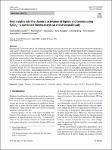Item Infomation
Full metadata record
| DC Field | Value | Language |
|---|---|---|
| dc.contributor.author | Guizani, Chamseddine | - |
| dc.contributor.author | Widste, Petri | - |
| dc.contributor.author | Siipola, Virpi | - |
| dc.date.accessioned | 2023-09-15T02:46:07Z | - |
| dc.date.available | 2023-09-15T02:46:07Z | - |
| dc.date.issued | 2023 | - |
| dc.identifier.uri | https://link.springer.com/article/10.1007/s42823-023-00601-4 | - |
| dc.identifier.uri | https://dlib.phenikaa-uni.edu.vn/handle/PNK/9032 | - |
| dc.description | Cc-BY | vi |
| dc.description.abstract | Engineering of activated carbons (ACs) through chemical activation of organic precursors has been extensively studied for a wide variety of biopolymers, biomasses, wastes and other fossil-based precursors. Despite huge efforts to engineer evermore performant and sustainable ACs, “searching-for-the-best-recipe” type of studies are more the rule than the exception in the published literature. Emerging AC applications related to energy and gas storage require strict control of the AC properties and a better understanding of the fundamentals underlying their engineering. In this study, we provide new insights into the K2CO3 chemical activation of plant-based polyphenols—lignins and tannins—through careful thermoanalytical and structural analyses. We showed for the the first time that the reactivity of polyphenols during K2CO3 chemical activation depends remarkably on their purity and structural properties, such as their content of inorganics, OH functionalities and average molecular weight. | vi |
| dc.language.iso | en | vi |
| dc.publisher | Springer | vi |
| dc.subject | ACs | vi |
| dc.subject | K2CO3 chemical activation | vi |
| dc.title | New insights into the chemical activation of lignins and tannins using K2CO3—a combined thermoanalytical and structural study | vi |
| dc.type | Book | vi |
| Appears in Collections | ||
| OER - Khoa học Vật liệu, Ứng dụng | ||
Files in This Item:

